安捷伦推出首款商品化组合切换系统SFCUHPLC
- 格式:doc
- 大小:26.00 KB
- 文档页数:1
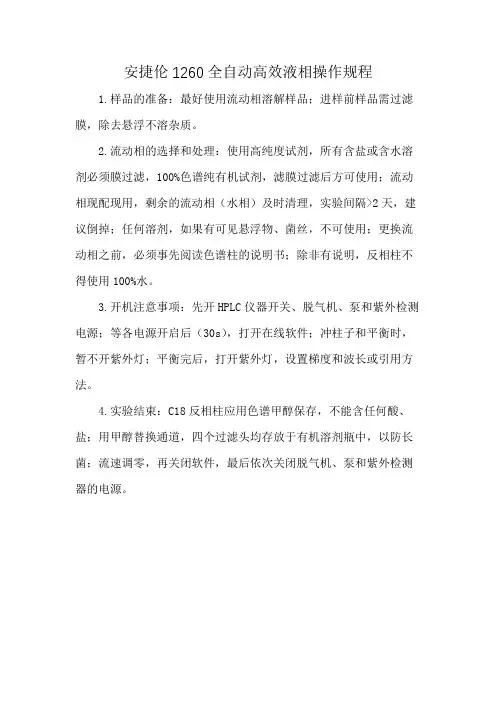
安捷伦1260全自动高效液相操作规程
1.样品的准备:最好使用流动相溶解样品;进样前样品需过滤膜,除去悬浮不溶杂质。
2.流动相的选择和处理:使用高纯度试剂,所有含盐或含水溶剂必须膜过滤,100%色谱纯有机试剂,滤膜过滤后方可使用;流动相现配现用,剩余的流动相(水相)及时清理,实验间隔>2天,建议倒掉;任何溶剂,如果有可见悬浮物、菌丝,不可使用;更换流动相之前,必须事先阅读色谱柱的说明书;除非有说明,反相柱不得使用100%水。
3.开机注意事项:先开HPLC仪器开关、脱气机、泵和紫外检测电源;等各电源开启后(30s),打开在线软件;冲柱子和平衡时,暂不开紫外灯;平衡完后,打开紫外灯,设置梯度和波长或引用方法。
4.实验结束:C18反相柱应用色谱甲醇保存,不能含任何酸、盐;用甲醇替换通道,四个过滤头均存放于有机溶剂瓶中,以防长菌;流速调零,再关闭软件,最后依次关闭脱气机、泵和紫外检测器的电源。
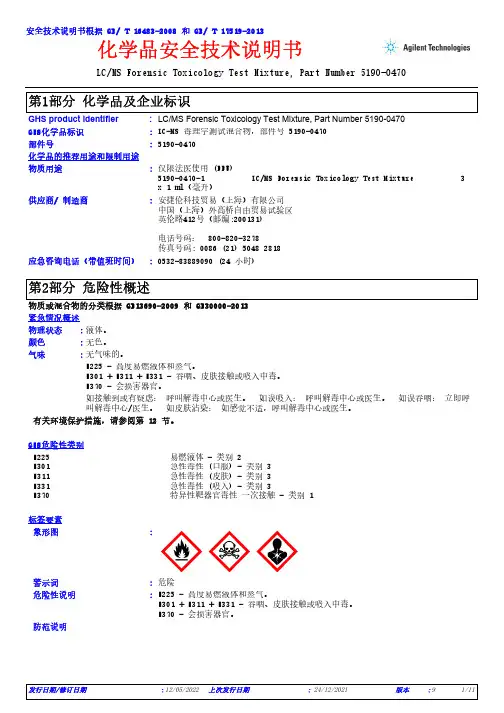
LC/MS Forensic Toxicology Test Mixture, Part Number 5190-0470*************(24小时)化学品安全技术说明书GHS product identifier 应急咨询电话(带值班时间)::供应商/ 制造商:安捷伦科技贸易(上海)有限公司中国(上海)外高桥自由贸易试验区英伦路412号(邮编:200131)电话号码: 800-820-3278传真号码: 0086 (21) 5048 2818LC/MS Forensic Toxicology Test Mixture, Part Number 5190-0470化学品的推荐用途和限制用途5190-0470部件号:物质用途:仅限法医使用 (FFU)5190-0470-1 LC/MS Forensic Toxicology Test Mixture 3 x 1 ml(毫升)安全技术说明书根据 GB/ T 16483-2008 和 GB/ T 17519-2013GHS化学品标识:LC-MS 毒理学测试混合物,部件号 5190-0470有关环境保护措施,请参阅第 12 节。
物质或混合物的分类根据 GB13690-2009 和 GB30000-2013紧急情况概述液体。
无色。
无气味的。
如接触到或有疑虑: 呼叫解毒中心或医生。
如误吸入: 呼叫解毒中心或医生。
如误吞咽: 立即呼叫解毒中心/医生。
如皮肤沾染: 如感觉不适,呼叫解毒中心或医生。
H225 - 高度易燃液体和蒸气。
H301 + H311 + H331 - 吞咽、皮肤接触或吸入中毒。
H370 - 会损害器官。
物理状态:颜色:气味:GHS危险性类别警示词:危险危险性说明:H225 - 高度易燃液体和蒸气。
H301 + H311 + H331 - 吞咽、皮肤接触或吸入中毒。
H370 - 会损害器官。
:防范说明标签要素象形图H225易燃液体 - 类别 2H301急性毒性 (口服) - 类别 3H311急性毒性 (皮肤) - 类别 3H331急性毒性 (吸入) - 类别 3H370特异性靶器官毒性 一次接触 - 类别 1P210 - 远离热源、热表面、火花、明火及其他点火源。
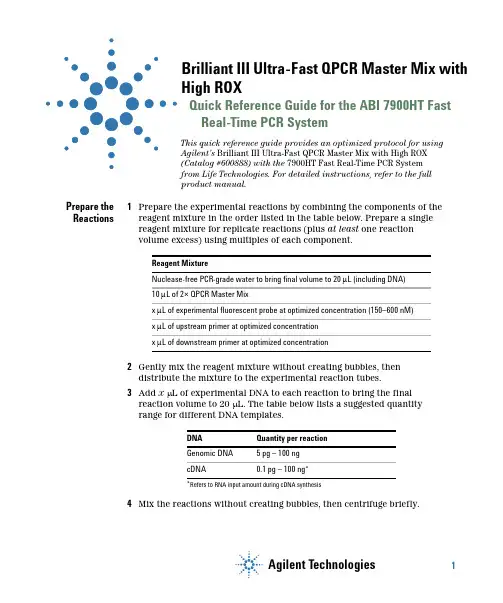
1Brilliant III Ultra-Fast QPCR Master Mix withHigh ROXQuick Reference Guide for the ABI 7900HT FastReal-Time PCR SystemAgilent Technologies This quick reference guide provides an optimized protocol for usingAgilent’s Brilliant III Ultra-Fast QPCR Master Mix with High ROX (Catalog #600888) with the 7900HT Fast Real-Time PCR System from Life Technologies. For detailed instructions, refer to the full product manual.Prepare theReactions 1Prepare the experimental reactions by combining the components of the reagent mixture in the order listed in the table below. Prepare a singlereagent mixture for replicate reactions (plus at least one reactionvolume excess) using multiples of each component.2Gently mix the reagent mixture without creating bubbles, thendistribute the mixture to the experimental reaction tubes.3Add x μL of experimental DNA to each reaction to bring the finalreaction volume to 20 μL. The table below lists a suggested quantityrange for different DNA templates.*Refers to RNA input amount during cDNA synthesis4Mix the reactions without creating bubbles, then centrifuge briefly.Reagent MixtureNuclease-free PCR-grade water to bring final volume to 20 μL (including DNA)10 μL of 2× QPCR Master Mixx μL of experimental fluorescent probe at optimized concentration (150–600 nM)x μL of upstream primer at optimized concentrationx μL of downstream primer at optimized concentrationDNA Quantity per reactionGenomic DNA 5 pg – 100 ngcDNA 0.1 pg – 100 ng*2Brilliant III Ultra-Fast QPCR Master Mix with High ROX Set Up theQPCR Plate andThermal Profile 1From the SDS software, click File > New to open the Plate Document Wizard.2Enter the appropriate assay and well information for a new experiment.3Click OK . The Wizard will close and the plate document will appear inthe main software window.4Click Add Detector , and select the correct reporter for the assay. ClickCopy to Plate Document , then click Done .5Highlight the wells that will contain samples and check the selectedreporter dye.6On the Instrument/Thermal Profile tab, enter a sample volume of 20 Land select the Fast run mode. Adjust the thermal cycling conditionsaccording to the image below, and set the instrument to reportfluorescence during the 60°C step of each cycle.Run the PCRProgram1Place the reactions in the 7900HT instrument.2On the Instrument/Real Time tab, click Start Run .Analyze Data 1Analyze the results of the run as needed for your experiment.Manual Part Number 5990-7250, Revision B0©Agilent Technologies, Inc. 2015For Research Use Only. Not for use in diagnostic procedures.Product InformationCatalog #600888, 400 reactions Ordering Information By phone (US and Canada*): 800-227-9770On the web: /genomics Technical Services By phone (US and Canada*): 800-227-9770Byemail:*************************For other countries, please contact your local sales representative at /genomics/contactus。
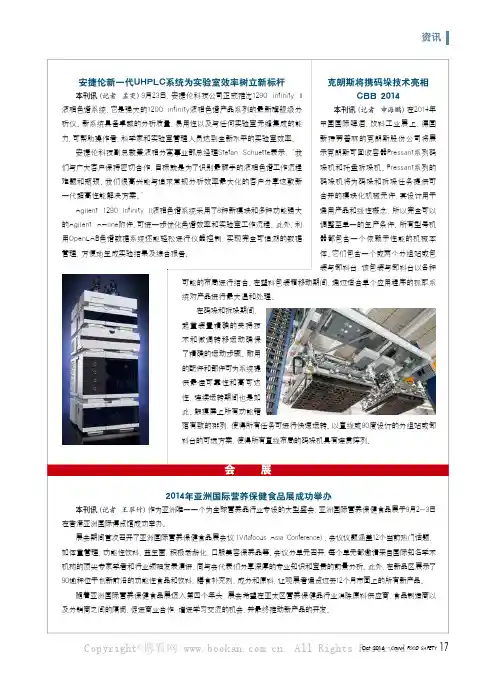
Oct 2014 CHINA FOOD SAFETY 17资讯安捷伦新一代UHPLC系统为实验室效率树立新标杆本刊讯(记者 孟雯)9月23日,安捷伦科技公司正式推出1290 infinity II 液相色谱系统,它是强大的1200 Infinity液相色谱产品系列的最新旗舰级分析仪。
新系统具备卓越的分析质量、易用性以及与任何实验室无缝集成的能力,可帮助操作者、科学家和实验室管理人员达到全新水平的实验室效率。
安捷伦科技副总裁兼液相分离事业部总经理Stefan Schuette表示:“我们与广大客户保持密切合作,目标就是为了识别最棘手的液相色谱工作流程难题和瓶颈。
我们很高兴能与追求常规分析效率最大化的客户分享这款新一代超高性能解决方案。
”Agilent 1290 Infinity II液相色谱系统采用了8种新模块和多种功能强大的Agilent A-line附件,可进一步优化色谱效率和实验室工作流程。
此外,利用OpenLAB色谱数据系统还能轻松进行仪器控制、实现完全可追溯的数据管理、方便地生成实验结果及综合报告。
克朗斯将携码垛技术亮相CBB 2014本刊讯(记者 申海鹏)在2014年中国国际啤酒、饮料工业展上,德国新特劳普林的克朗斯股份公司将展示克朗斯可回收容器Pressant系列码垛机和托盘拆垛机。
Pressant系列的码垛机将为码垛和拆垛任务提供可合并的模块化机械元件,其设计用于通用产品和线性概念,所以完全可以调整至单一的生产条件。
所有型号机器都包含一个依赖于性能的机械本体。
它们包含一个或两个分组站或包装与卸料台,该包装与卸料台以各种会展2014年亚洲国际营养保健食品展成功举办本刊讯(记者 王翠竹)作为亚洲唯一一个为全球营养品行业专设的大型盛会,亚洲国际营养保健食品展于9月2~3日在香港亚洲国际博览馆成功举办。
展会期间首次召开了亚洲国际营养保健食品展会议(Vitafoods Asia Conference),会议议题涵盖12个当前热门话题,如体重管理、功能性饮料、益生菌、积极老龄化、口服美容保养品等。
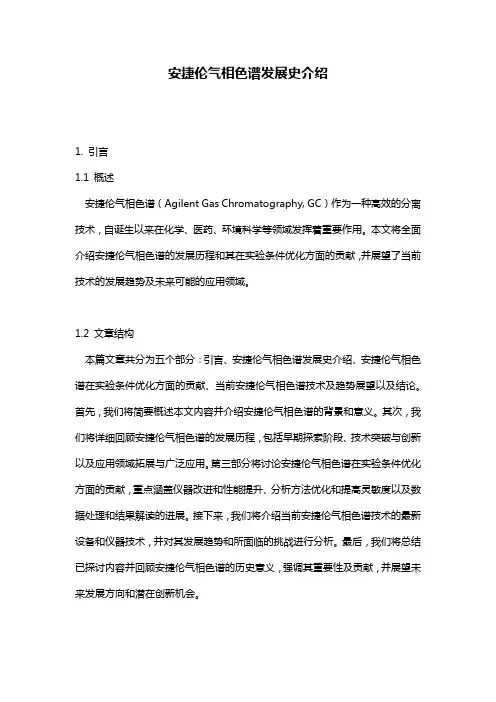
安捷伦气相色谱发展史介绍1. 引言1.1 概述安捷伦气相色谱(Agilent Gas Chromatography, GC)作为一种高效的分离技术,自诞生以来在化学、医药、环境科学等领域发挥着重要作用。
本文将全面介绍安捷伦气相色谱的发展历程和其在实验条件优化方面的贡献,并展望了当前技术的发展趋势及未来可能的应用领域。
1.2 文章结构本篇文章共分为五个部分:引言、安捷伦气相色谱发展史介绍、安捷伦气相色谱在实验条件优化方面的贡献、当前安捷伦气相色谱技术及趋势展望以及结论。
首先,我们将简要概述本文内容并介绍安捷伦气相色谱的背景和意义。
其次,我们将详细回顾安捷伦气相色谱的发展历程,包括早期探索阶段、技术突破与创新以及应用领域拓展与广泛应用。
第三部分将讨论安捷伦气相色谱在实验条件优化方面的贡献,重点涵盖仪器改进和性能提升、分析方法优化和提高灵敏度以及数据处理和结果解读的进展。
接下来,我们将介绍当前安捷伦气相色谱技术的最新设备和仪器技术,并对其发展趋势和所面临的挑战进行分析。
最后,我们将总结已探讨内容并回顾安捷伦气相色谱的历史意义,强调其重要性及贡献,并展望未来发展方向和潜在创新机会。
1.3 目的本文的目的是系统介绍安捷伦气相色谱的发展历程及其在实验条件优化方面的贡献,并提出当前技术发展趋势及未来可能的应用领域。
通过本文的阐述,读者能够更全面地了解安捷伦气相色谱技术在科学研究与实际应用中所起到的重要作用,并为相关领域研究人员提供参考和启示。
同时,本文也为相关企业和科技工作者指明了未来技术发展方向,为行业创新提供支持与推动。
2. 安捷伦气相色谱发展史介绍2.1 创始和早期探索安捷伦气相色谱(Agilent Gas Chromatography)作为一项重要的分析技术,起源于20世纪中期。
在当时,化学家对于快速、高效地分离和鉴定化合物的需求越来越大。
安捷伦公司则成为了这一需求下发展起来的先驱者。
在早期探索阶段,研究人员们通过不断尝试和实践来改进气相色谱技术。
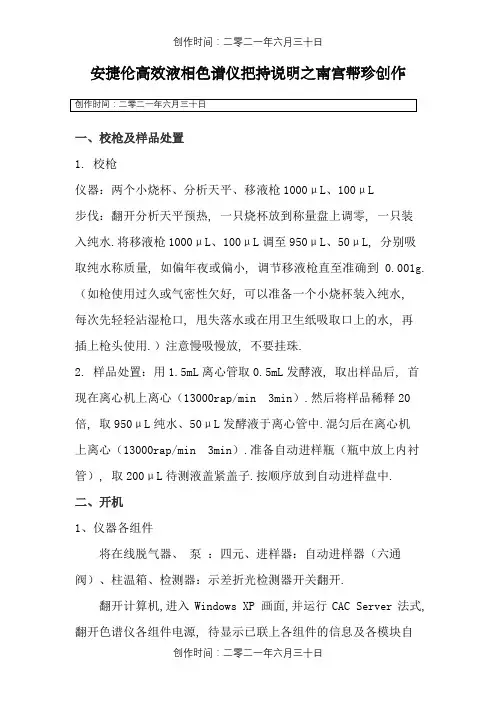
安捷伦高效液相色谱仪把持说明之南宫帮珍创作一、校枪及样品处置1. 校枪仪器:两个小烧杯、分析天平、移液枪1000μL、100μL步伐:翻开分析天平预热, 一只烧杯放到称量盘上调零, 一只装入纯水.将移液枪1000μL、100μL调至950μL、50μL, 分别吸取纯水称质量, 如偏年夜或偏小, 调节移液枪直至准确到0.001g.(如枪使用过久或气密性欠好, 可以准备一个小烧杯装入纯水,每次先轻轻沾湿枪口, 甩失落水或在用卫生纸吸取口上的水, 再插上枪头使用.)注意慢吸慢放, 不要挂珠.2. 样品处置:用1.5mL离心管取0.5mL发酵液, 取出样品后, 首现在离心机上离心(13000rap/min 3min).然后将样品稀释20倍, 取950μL纯水、50μL发酵液于离心管中.混匀后在离心机上离心(13000rap/min 3min).准备自动进样瓶(瓶中放上内衬管), 取200μL待测液盖紧盖子.按顺序放到自动进样盘中.二、开机1、仪器各组件将在线脱气器、泵:四元、进样器:自动进样器(六通阀)、柱温箱、检测器:示差折光检测器开关翻开.翻开计算机,进入Windows XP 画面,并运行CAC Server法式, 翻开色谱仪各组件电源, 待显示已联上各组件的信息及各模块自检完成后, 双击Instrument 1 Online , 图标翻开工作站.化学工作站自动与1200LC通讯.流动相:将流动相(一般不主张使用偏酸、偏碱的流动相)放入溶剂瓶中, 翻开冲刷阀, 设流速为2ml/min, 单击确定 , 再依次单击泵→控制, 选中启动, 单击确定, 则系统开始冲刷, 至管路无气泡为止, 切换管路反复把持至所需管路均无气泡.在“控制”选项中选“关闭”, 关闭泵, 关闭冲刷阀.单击泵下面瓶图标, 输入溶剂的实际体积和瓶体积.每次四元泵开始前, 要翻开冲刷阀阀门以5ml/min的流速冲刷10分钟, 使脱气机与泵之间的流动相从冲刷阀流出, 以免隔夜的流动相损伤色谱柱.每次进样检测前, 要用流动相冲刷色谱柱30分钟, 到达柱温前20min流速设为0.2ml/min, 达柱温后再改为0.6ml/min.待1—1.5h检测器的基线稳定方可进行进样检测;检测结束后, 色谱柱要先用水冲刷20分钟, 然后用甲醇或乙腈冲刷至少20分钟,以延长色谱柱的使用寿命.绝对禁止偏酸、偏碱的流动相以及缓冲液在色谱柱中过夜.三、编纂分析方法新方法建立:法式菜单显示绿色, 即可进行参数设置及把持泵参数设定:设定流速、比例、运行时间、平衡时间、泵辅助设定(梯度)等.点击确定进入下一画面自动进样器参数设定:设定进样量(5μL)、抽取位置(调节针高度 3.0mm)、进样方式等.“序列”→序列参数→子目录(日期:年月日时间)“序列表”:拔出/批量输入向导→“追加”、“拔出”→“样品位置”、“开始位置”、“增量”、“拔出行数”标准进样:只能输入进样体积, 此方式无洗针功能.洗针进样:可以输入进样体积和洗瓶位置此方式针从样品瓶抽完样品后会在洗瓶中洗针.柱温箱参数设定:测按时75℃, 反冲时80℃.(在”温度”下面的方框内输入所需温度,并选中它,点击”更多>>”键,选中“与左侧相同”使柱温箱的温度左右一致, 点击“确定”进入下一界面.检测器参数设定-示差参比池冲刷:10min(校零).不需要每次都冲刷.温度设置50℃(不要设很高, 与检测器温度相立即可)选中点击确定进入下一画面方法保管单击方法另存为输入一—方法名, 如test 单击确认选择已有方法:点击【Method】, 点击【Load method】选项, 选取已存的各种把持方法.四、样品分析与收集数据将样品放于样品盘中相应位置, 所有的样品均需廓清.“序列”→“序列参数”:依照自动进样盘上的样品瓶的顺序编写参数(样品瓶位置、名称、方法).待仪器显示Ready, 基线平稳, 从【Run control】菜单中选择【Run Method】, 开始进样分析.或点击“开始”开始进样分析.数据处置:单击【View】菜单, 单击【Data analysis】选项, 进行数据分析.单击【View】菜单, 单击【Method and Run control】选项, 回到样品分析界面.数据分析方法编纂从File 菜单选择Load signal 选中您的数据文件名, 单击Ok积分:从“积分”中选择“积分”,如积分结果不理想,再从菜单中选择“积分事件”选项选择合适的斜率灵敏度、峰宽、最小峰面积、最小峰高从积分菜单中选择积分选项则数据被积分如积分结果不理想则修改相应的积分参数直到满意为止单击左边图标将积分参数存入方法五、标准曲线的绘制1.称取葡萄糖、果糖、蔗糖(恒重)各1g准确到, 稀释到1000mL容量瓶中.2.将标准溶液摇匀, 用离心管取糖标液, 准备自动进样瓶(瓶中放上内衬管), 取200μL待测液盖紧盖子.3.设置:将样品放于样品盘中相应位置, 所有的样品均需廓清.“序列”→“序列参数”:依照自动进样盘上的样品瓶的顺序编写参数(样品瓶位置、名称、方法、进样量:相应成梯度的量).用浓度和峰面积回归, 就获得了标准曲线7、关机冲刷系统:反相柱用10%的甲醇水冲刷系统30分钟, 再用100%甲醇冲刷系统20分钟, 然后关泵, 正相柱先用合适溶剂冲刷, 后用柱保管液冲刷.退收工作站, 关闭计算机.关闭10%异丙醇溶液控制阀.关闭仪器各组件关失落电源开关8、注意事项⑴、色谱柱使用前仔细阅读色谱柱附带的说明书, 注意适用范围, 如pH值范围、流动相类型等;必需使用呵护柱;色谱柱长时间不用时, 柱内应布满溶剂, 两端封死保管.⑵、流动相使用前必需过滤, 不要使用多日寄存的蒸馏水(易长菌).⑶、仪器运行时, 泵头必需用10%异丙醇水溶液虹吸冲刷, 不能干涸.⑷、注意各流动相所剩溶液的容积设定, 若设定的容积低于最低限会自动停泵.⑸、对手动进样器当使用缓冲溶液时要用水冲刷进样口同时挪动转移进样阀数次每次数毫升⑹、若使用含盐流动相, 开机时必需先用10%甲醇水溶液冲刷20分钟以上再换上含盐流动相.⑺、溶剂瓶中的沙芯过滤头容易破碎, 在更换流动相时注意呵护, 当发现过滤头变脏或长菌时, 不成用超声洗涤, 可用35%稀硝酸溶液浸泡后再洗涤.⑻、检测器的灯有使用寿命限制, 一般在正式进样分析前30min 左右开启D灯或W灯, 分析结束, 立即关灯.⑼、使用双泵时, A、B、C、D四相中, 若所用流动相中有含盐流动相, 则A、D(进液口位于混合器下方)放置含盐流动相, B、C (进液口位于混合器上方)放置不含盐流动相.9、如何防止溶剂瓶内溶剂过滤器的梗塞及其处置请严格执行溶剂过滤请勿使用多日寄存的蒸馏水及磷酸盐缓冲液如果应用许可可在溶剂中加入0.0001---0.001M的叠氮化钠.在溶剂瓶内溶剂的上方小流量连续吹氩气,以隔绝空气防止使溶剂瓶流露在直射阳光下尽量使用琥珀色的溶剂瓶盛放水溶液或磷酸盐缓冲液梗塞后的处置法方法:将过滤头从组件中取下在35%硝酸液中浸泡1h, 然后用二次蒸馏水冲刷干净.不能超生清洗.10、泵的维护⑴、流动相使用前必需脱气过滤⑵、使用缓冲盐时要加在线Seal-wash选项⑶、关机前反相色谱柱用10%的甲醇水冲刷系统20分钟, 然后用有机溶剂冲刷系统10分钟, 然后关泵.正相色谱柱用适当的溶剂冲刷.⑷、及时更换Purge Valve内的过滤芯, 当翻开Purge Valve时压力高于10bar 标明过滤芯已堵⑸、使用合适的密封圈:标准密封圈能适合于年夜大都应用.但使用正相溶剂最好使用聚四氟乙烯密封圈, 泵的压力限制最年夜压力设为200bar.⑹、使用梯度比例时的注意事项:当盐溶液与有机溶剂溶液混合时盐溶液能与有机溶剂溶液完全混溶而不会呈现沉淀.由于在比例阀的混合点重力作用使盐颗粒沉淀下来通常阀A接水相/盐溶液D接有机溶剂此法连接可有效使盐回落到盐溶液中并被溶解若倒置过来盐可能落在有机溶剂中呈现问题当使用缓冲盐溶液和有机溶剂时推荐将缓冲盐通道接在A通道上有机溶剂通道直接接在A通道的上方D通道上按期用水冲刷所有的通道以除去阀口上可能呈现的盐沉淀11、自动进样器使用注意使用自动洗针功能自动洗针功能可以把法式设置为“带有洗针的进样”,或将自动洗针功能包含在进样器法式中.当使用自动洗针功能时, 进样针在。
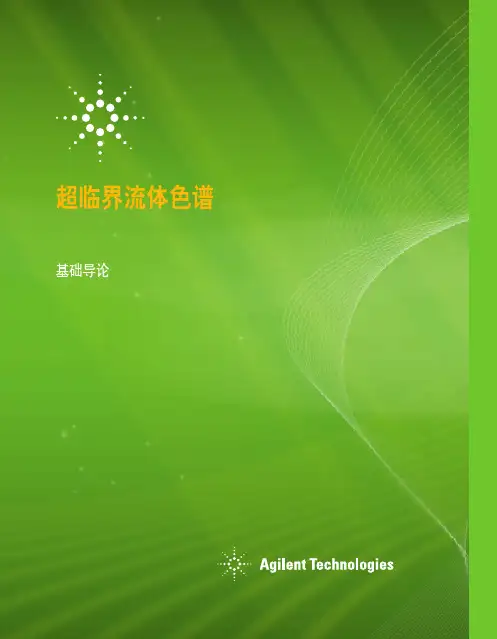
超临界流体色谱超临界流体色谱基础导论Terry A. Berger本文中的信息、说明和指标如有变更,恕不另行通知。
© 安捷伦科技公司,20152015 年 7 月 1 日,中国印刷5991-5509CHCN目录目录 III前言 VI作者简介 XI引言 XIII符号 XIV缩写 XIV1 超临界流体色谱简介 11.1 什么是 SFC 11.2 为什么采用 SFC 21.3 SFC 能够分离哪些化合物 121.4 这一名称的含义 162 流动相 192.1 为什么使用 CO2 192.2 使用 100% CO2 212.3 改性剂或共溶剂 232.4 添加剂 312.5 添加水以扩展溶质极性 343 固定相 353.1 材料 353.2 非手性键合相 353.3 固定相比较 403.4 填料粒径与色谱柱尺寸之间的关系 413.5 推荐的色谱柱尺寸 453.6 用于手性分离的色谱柱 48III4 流动相变量对保留值和选择性的影响 494.1 改性剂浓度 494.2 温度 504.3 压力 534.4 流速 554.5 可控变量对保留时间和选择性的影响概述 575 方法开发 585.1 溶质与固定相极性的匹配 585.2 极性窗口 605.3 入门指南 605.4 极性溶质 615.5 低极性溶质 645.6 多变量方法 656 非手性分离 666.1 案例研究 1 —典型的低极性样品 666.2 案例研究 2 —中等极性样品 716.3 案例研究 3 —磺胺类药物 836.4 其他结果 897 手性分离 907.1 背景 907.2 对映体过量率测定 917.3 用于手性分离的正相技术 917.4 可控变量对手性分离的影响 937.5 开发手性方法 98 IV8 SFC 定量分析 103 8.1 验证阶段 103 8.2 开发方法用于定量分析饮料和食品中的山梨酸盐、苯甲酸盐和咖啡因 105 8.3 校正 108 8.4 苯甲酸盐、山梨酸盐和咖啡因的定量分析结果总结 1168.5 手性分离 1169 仪器注意事项 121 9.1 泵 121 9.2 UV 检测器优化 124 9.3 双梯度 137 9.4 自动进样器注意事项 138 9.5 其他 146 9.6 SFC 的超高性能 148 9.7 在 SFC 与 HPLC 之间切换的混合型系统 150 9.8 质谱接口 154 9.9 其他检测器 156参考文献159V前言作者 Terry Berger 在我们如今称之为超临界流体色谱 (SFC) 的领域中拥有独特的丰富经历,是撰写本基础导论的不二人选。
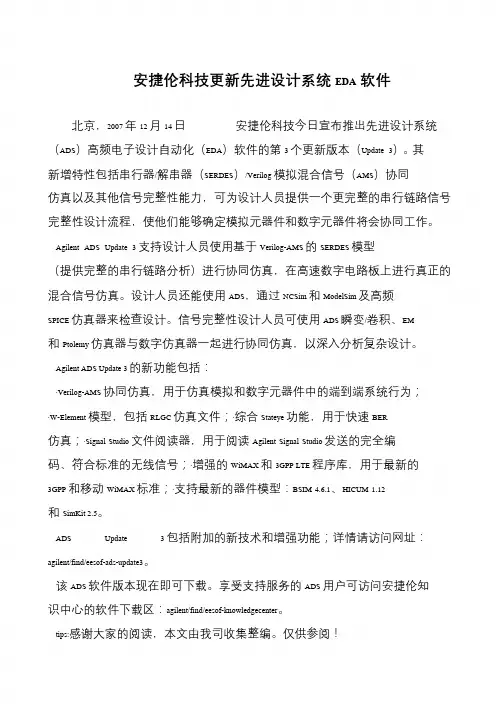
安捷伦科技更新先进设计系统EDA软件北京,2007 年12 月14 日安捷伦科技今日宣布推出先进设计系统(ADS)高频电子设计自动化(EDA)软件的第3 个更新版本(Update 3)。
其新增特性包括串行器/解串器(SERDES)/Verilog 模拟混合信号(AMS)协同仿真以及其他信号完整性能力,可为设计人员提供一个更完整的串行链路信号完整性设计流程,使他们能够确定模拟元器件和数字元器件将会协同工作。
Agilent ADS Update 3 支持设计人员使用基于Verilog-AMS 的SERDES 模型(提供完整的串行链路分析)进行协同仿真,在高速数字电路板上进行真正的混合信号仿真。
设计人员还能使用ADS,通过NCSim 和ModelSim 及高频SPICE 仿真器来检查设计。
信号完整性设计人员可使用ADS 瞬变/卷积、EM和Ptolemy 仿真器与数字仿真器一起进行协同仿真,以深入分析复杂设计。
Agilent ADS Update 3 的新功能包括:·Verilog-AMS 协同仿真,用于仿真模拟和数字元器件中的端到端系统行为;·W-Element 模型,包括RLGC 仿真文件;·综合Stateye 功能,用于快速BER 仿真;·Signal Studio 文件阅读器,用于阅读Agilent Signal Studio 发送的完全编码、符合标准的无线信号;·增强的WiMAX 和3GPP LTE 程序库,用于最新的3GPP 和移动WiMAX 标准;·支持最新的器件模型:BSIM 4.6.1、HICUM 1.12 和SimKit 2.5。
ADS Update 3 包括附加的新技术和增强功能;详情请访问网址:agilent/find/eesof-ads-update3。
该ADS 软件版本现在即可下载。
享受支持服务的ADS 用户可访问安捷伦知识中心的软件下载区:agilent/find/eesof-knowledgecenter。
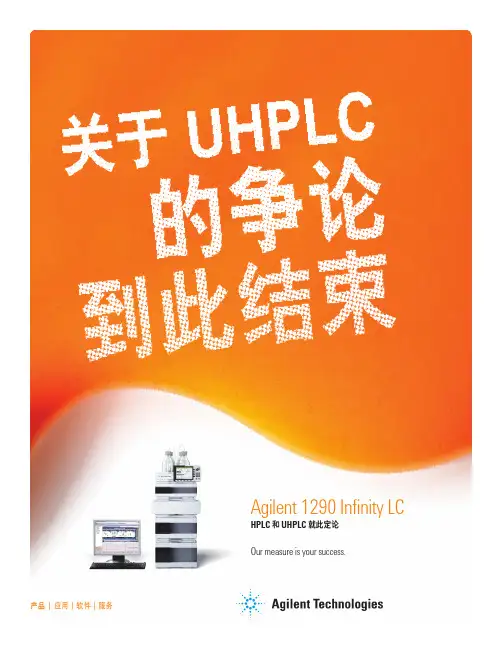
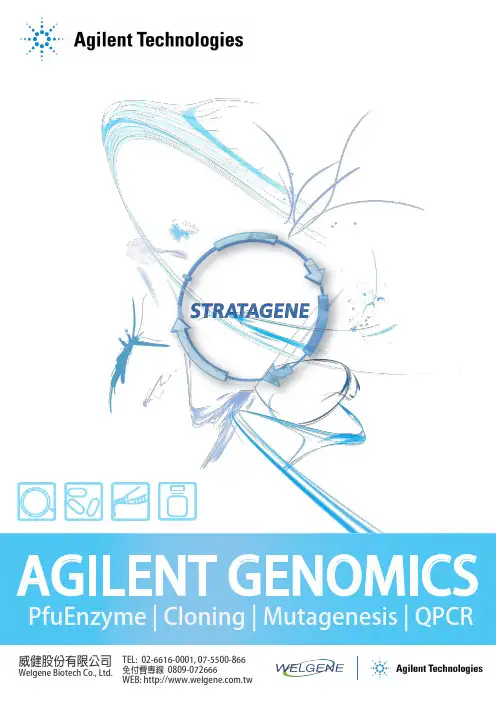
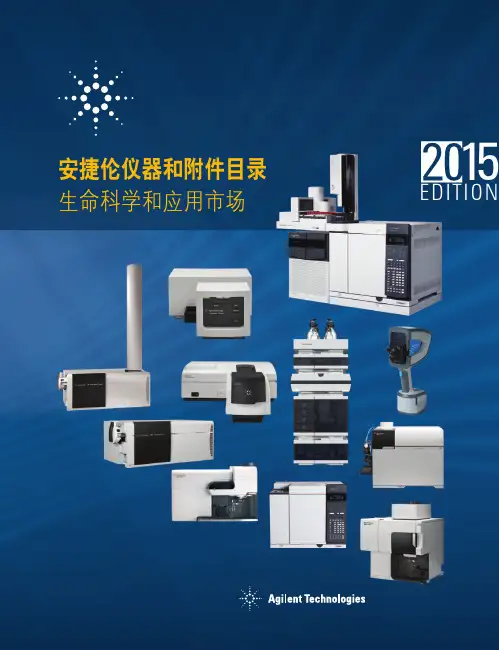
Brilliant III Ultra-Fast SYBR® Green QPCR Master Mix with Low ROXCatalog #600892600903ProtocolVersion C0, January 2015For Research Use Only. Not for Use in Diagnostic Procedures.Notices© Agilent Technologies, Inc. 2015No part of this manual may be reproduced in any form or by any means (including elec-tronic storage and retrieval or translation into a foreign language) without prior agree-ment and written consent from Agilent Technologies, Inc. as governed by United States and international copyright laws. Manual Part Number600892-12EditionVersion C0, January 2015Printed in USAAgilent Technologies, Inc.5301 Stevens Creek RdSanta Clara, CA 95051 USA WarrantyThe material contained in thisdocument is provided “as is,” andis subject to being changed, with-out notice, in future editions. Fur-ther, to the maximum extentpermitted by applicable law, Agi-lent disclaims all warranties,either express or implied, withregard to this manual and anyinformation contained herein,including but not limited to theimplied warranties of merchant-ability and fitness for a particularpurpose. Agilent shall not be lia-ble for errors or for incidental orconsequential damages in con-nection with the furnishing, use,or performance of this documentor of any information containedherein. Should Agilent and theuser have a separate writtenagreement with warranty termscovering the material in this doc-ument that conflict with theseterms, the warranty terms in theseparate agreement shall control.Technology LicensesThe hardware and/or software described inthis document are furnished under a licenseand may be used or copied only in accor-dance with the terms of such license.Restricted Rights LegendU.S. Government Restricted Rights. Soft-ware and technical data rights granted tothe federal government include only thoserights customarily provided to end user cus-tomers. Agilent provides this customarycommercial license in Software and techni-cal data pursuant to FAR 12.211 (TechnicalData) and 12.212 (Computer Software) and,for the Department of Defense, DFARS252.227-7015 (Technical Data - CommercialItems) and DFARS 227.7202-3 (Rights inCommercial Computer Software or Com-puter Software Documentation).Safety NoticesA CAUTION notice denotes a haz-ard. It calls attention to an operat-ing procedure, practice, or the likethat, if not correctly performed oradhered to, could result in damageto the product or loss of importantdata. Do not proceed beyond aCAUTION notice until the indicatedconditions are fully understood andA WARNING notice denotes ahazard. It calls attention to anoperating procedure, practice, orthe like that, if not correctly per-formed or adhered to, could resultin personal injury or death. Do notproceed beyond a WARNINGnotice until the indicated condi-tions are fully understood andTechnical SupportFor technical product support, contact Agilent at (800) 227-9770 or************************ EndnotesSYBR® Green is a registered trademark of Molecular Probes, Inc.In this Guide...This document describes how to use the Agilent Brilliant IIIUltra-Fast SYBR® Green QPCR Master Mix with Low ROX toperform quantitative PCR amplifications with an acceleratedcycling protocol.1Before You BeginThis chapter provides important information on gettingstarted with a QPCR experiment using the Brilliant IIIUltra-Fast SYBR® Green QPCR Master Mix with Low ROX.2ProceduresThis chapter provides guidelines and instructions on how toperform QPCR with the Brilliant III Ultra-Fast SYBR® GreenQPCR Master Mix with Low ROX.3TroubleshootingContents1Before You Begin6Notices to Purchaser7Kit contents8Storage conditions for the master mix8Required reagents and equipment8Overview of the Brilliant III Ultra-Fast SYBR Green QPCR Master Mix with Low ROX92Procedures10Preprotocol Considerations11PCR Primers 11Magnesium Chloride 11Data Acquisition with a Spectrofluorometric Thermal Cycler 12Multiplex PCR 12Preventing Template Cross-Contamination 12QPCR Protocol13Prepare the reactions13Run the PCR cycling program15Generate a dissociation curve163Troubleshooting18If the increase in fluorescence with cycling is low or nonexistant19If the level of primer-dimer and nonspecific products is high19ContentsBrilliant III Ultra-Fast SYBR® Green QPCR Master Mix with Low ROXProtocol1Before You BeginNotices to Purchaser7Kit contents8Storage conditions for the master mix8Required reagents and equipment8Overview of the Brilliant III Ultra-Fast SYBR Green QPCR Master Mix with Low ROX9This chapter provides important information on getting started with a QPCR experiment using the Brilliant III Ultra-Fast SYBR® Green QPCR Master Mix with Low ROX.1Before You BeginNotices to PurchaserNotices to PurchaserThis product is provided under an intellectual property license from LifeTechnologies Corporation. The purchase of this product conveys to thebuyer the non-transferable right to use the purchased product andcomponents of the product only in research conducted by the buyer(whether the buyer is an academic or for-profit entity). The sale of thisproduct is expressly conditioned on the buyer not using the product or itscomponents for any Commercial Purposes. Commercial Purposes meansany activity by the buyer to generate revenue, which may include, but isnot limited to use of the product or its components: (1) in manufacturingor in quality assurance or quality control; (2) to provide a service,information, or data for a fee or other consideration; (3) for therapeutic orprophylactic purposes; (4) for diagnostic use; and (5) for resale, whetheror not such items are resold for use in research. For information onpurchasing a license to this product for purposes other than research,contact Life Technologies Corporation, 5791 Van Allen Way, Carlsbad , CA***********************************.LIMITED LICENSE: Use of this product is covered by one or more of thefollowing US patents and corresponding patent claims outside the US:6,258,569, 6,171,785, 6,127,155, 6,030,787, 5,994,056, 5,876,930, 5,804,375,5,789,224, 5,773,258 (claims 1 and 6 only), 5,723,591, 5,677,152 (claims 1to 23 only), 5,618,711, 5,538,848, and claims outside the US correspondingto expired US Patent No. 5,079,352. The purchase of this product includesa limited, non-transferable immunity from suit under the foregoing patentclaims for using only this amount of product for the purchaser’s owninternal research. No right under any other patent claim and no right toperform commercial services of any kind, including without limitationreporting the results of purchaser’s activities for a fee or other commercialconsideration, is conveyed expressly, by implication, or by estoppel. Thisproduct is for research use only. Diagnostic uses under Roche patentsrequire a separate license from Roche. Further information on purchasinglicenses may be obtained by contacting the Director of Licensing, AppliedBiosystems, 850 Lincoln Centre Drive, Foster City, California 94404, USA.Before You Begin1Kit contents Kit contentsTable1 shows the materials provided with the Brilliant III Ultra-Fast SYBR ® Green QPCR Master Mix with Low ROX.Sufficient reagents are provided for four hundred 20-μL QPCR reactions.* The concentration of ROX dye in the final reactions is 30 nM.Storage conditions for the master mixStore at –20°C upon receipt. After thawing, the master mix may be stored at 4°C for one month or returned to –20°C for long term storage.The master mix is light sensitive and should be kept away from light whenever possible.Required reagents and equipmentTable2 contains a list of reagents and equipment that are required for the QPCR protocol.Table 1Kit contents2× Brilliant III SYBR Green QPCR Master Mixwith Low ROX*600892 2 × 2 mL (400 20-μL reactions)60090320 × 2 mL (4000 20-μL reactions)Table 2Required Reagents and EquipmentSpectrofluorometric thermal cyclerNuclease-free PCR-grade water1Before You BeginOverview of the Brilliant III Ultra-Fast SYBR Green QPCR Master Mix with Low ROXOverview of the Brilliant III Ultra-Fast SYBR Green QPCR Master Mix with Low ROXThe Brilliant III Ultra-Fast SYBR Green QPCR Master Mix with Low ROXis a single-tube reagent designed for performing accelerated quantitativePCR amplifications using SYBR Green I dye for amplicon detection. Themaster mix includes components that enable it to perform optimally underfast cycling conditions:•A mutated form of Taq DNA polymerase that has been specificallyengineered for faster replication•An improved chemical hot start mechanism that promotes faster hotstart release to improve amplification specificity while keeping the runtime of the PCR protocol to a minimumReactions prepared with the low ROX master mix contain 30 nM of ROXreference dye. This concentration of ROX dye is suitable for Agilent’sreal-time PCR instruments (AriaMx, Mx3000P, and Mx3005P) and the ABI7500 Fast real-time PCR instrument from Applied Biosystems.The 2× master mix also contains SYBR Green I dye, dNTPs (nucleotidemix GATC), Mg2+, and a buffer specially formulated for fast cycling.Brilliant III Ultra-Fast SYBR® Green QPCR Master Mix with Low ROXProtocol2ProceduresPreprotocol Considerations11PCR Primers 11Magnesium Chloride 11Data Acquisition with a Spectrofluorometric Thermal Cycler 12Multiplex PCR 12Preventing Template Cross-Contamination 12QPCR Protocol13Prepare the reactions13Run the PCR cycling program15This chapter provides guidelines and instructions on how to perform QPCR with the Brilliant III Ultra-Fast SYBR® Green QPCR Master Mixwith Low ROX.2ProceduresPreprotocol ConsiderationsPreprotocol ConsiderationsPCR PrimersIt is critical in SYBR Green-based QPCR to minimize the formation ofnonspecific amplification products. This issue becomes more prominent atlow target concentrations. Therefore, to maximize the sensitivity of theassay, use the lowest concentration of primers possible withoutcompromising the efficiency of PCR. Take into consideration the relativeconcentrations of forward and reverse primers and the total primerconcentration. The optimal concentration of the upstream and downstreamPCR primers is the lowest concentration that results in the lowest Ct andan adequate fluorescence for a given target concentration, with minimal orno formation of primer-dimer. This concentration should be determinedempirically; generally, primer concentrations in the range of 200–500 nMare satisfactory.Magnesium ChlorideThe optimal MgCl2 concentration promotes maximal amplification of thespecific target amplicon with minimal nonspecific products andprimer-dimer formation. High levels of the Mg2+ ion tend to favor theformation of nonspecific dsDNA, including primer-dimers. Therefore, whenoptimizing a SYBR Green-based QPCR assay, keep the MgCl2 levels as lowas possible without compromising the efficiency of amplification of thespecific target (typically between 1.5 and 2.5 mM MgCl2). The Brilliant IIIUltra-Fast SYBR Green QPCR master mix contains MgCl2 at aconcentration of 2.5 mM (in the 1× solution), which is suitable for mosttargets. If desired, you can increase the concentration by adding a smallamount of a concentrated MgCl2 solution to the 1× experimental reactionat the time of setup.Procedures 2Data Acquisition with a Spectrofluorometric Thermal Cycler Data Acquisition with a Spectrofluorometric Thermal Cycler Set the instrument to collect SYBR Green I data in real-time at theannealing/extension step of each cycle. How this is accomplished willdepend on the software that commands the particular instrument you areusing. Consult the manufacturer’s instruction manual for the instrumentand software version you are using.Multiplex PCRMultiplex PCR is the amplification of more than one target in a singlepolymerase chain reaction. Because SYBR Green I dye fluoresces in thepresence of any dsDNA, multiplexing with the Brilliant III Ultra-Fast SYBRGreen QPCR master mix is not recommended.Preventing Template Cross-ContaminationTake precautions to minimize the potential for carryover of nucleic acidsfrom one experiment to the next. Use separate work areas and pipettorsfor pre- and post-amplification steps. Use positive displacement pipets oraerosol-resistant pipet tips.2ProceduresQPCR ProtocolQPCR ProtocolPrepare the reactions1Prepare the experimental reactions by combining the followingcomponents in order . Prepare a single reagent mixture for duplicate experimental reactions and duplicate no-template controls (plus at least one reaction volume excess) using multiples of each component listed in Table 3.2Gently mix without creating bubbles (do not vortex), then distribute the mixture to individual PCR reaction tubes.3Add x μL of experimental DNA to each reaction. Table 4 lists a suggested quantity range for different DNA templates.Once the tube containing the 2× QPCR master mix is thawed, store it on ice while setting up the reactions. Following initial thawing of the master mix, store the unused portion at 4°C for up to one month, or return to –20°C for long term storage. Avoid multiple freeze-thaw cycles.Set up a no-template control reaction to screen for contamination of reagents or false amplification.Keep all solutions containing the master mix protected from light as much as possible.Table 3QPCR reagent mixtureNuclease-free PCR-grade water X μL (enough to yield a final reaction volume of 20 μL,including experimental DNA)2× Brilliant III SYBR Green QPCR Master Mix with Low ROX 10 μLUpstream primer X μL (200–500 nM final concentration)Downstream primerX μL (200–500 nM final concentration)Procedures 2Prepare the reactions Table 4Quantity of template DNA per reactionGenomic DNA 5 pg – 50 ngcDNA0.5 pg – 100 ng** Refers to RNA input amount during cDNA synthesis4Gently mix the reactions without creating bubbles (do not vortex), then centrifuge the reactions briefly.Bubbles interfere with fluorescence detection2ProceduresRun the PCR cycling programRun the PCR cycling program•Place the reactions in the instrument. Run the cycling program shown below that is appropriate for your instrument. Set the intrument to detect and report fluorescence at each cycle during the 60°C annealing/extension step.* Initial 3-minute incubation is required to activate the DNA polymerase.For optimal performance, the durations of the denaturation and annealing/extension steps may need to be adjusted for each target. Genomic targets generally require longerdenaturation and annealing/extension times than low-complexity targets (e.g. cDNA and plasmid DNA).Table 5PCR program for the Agilent AriaMx1195°C3 minutes*24095°C 5 seconds 60°C5–10 secondsTable 6PCR program for the Agilent Mx3000P or Mx3005P1195°C 3 minutes*24095°C 5–20 seconds 60°C20 secondsTable 7PCR program for the ABI 7500 Fast1195°C 3 minutes*24095°C 5 seconds 60°C12 secondsProcedures 2Generate a dissociation curve Generate a dissociation curveFor your specific instrument, follow the manufacturer’s guidelines forgenerating dissociation curves.2ProceduresGenerate a dissociation curveBrilliant III Ultra-Fast SYBR® Green QPCR Master Mix with Low ROX Protocol3TroubleshootingIf the increase in fluorescence with cycling is low or nonexistant19 If the level of primer-dimer and nonspecific products is high193TroubleshootingIf the increase in fluorescence with cycling is low or nonexistantIf the increase in fluorescence with cycling is low or nonexistant The target length is too long for sufficient amplification with fast cycling.✔Design the primers so that the PCR product is <300 bp in length.The DNA polymerase is not functioning optimally.✔Make sure that the 3-minute initial incubation at 95°C was performedas part of the cycling program.✔Make sure that the initial 95°C incubation was not longer than 3minutes.The reaction is not optimized and insufficient product is formed.✔Test for formation of enough specific product by gel electrophoresis.✔Optimize the primer concentration.✔The MgCl2 concentration in the 1× master mix is 2.5 mM. Try addingsmall amounts of concentrated MgCl2 (not included in this kit) to theexperimental reactions to increase the MgCl2 concentration.The concentration or quality of the template is not optimal.✔Make sure that the correct concentration and amount of template wasused and that the template sample is of good quality. If unsure, makenew serial dilutions of template before repeating PCR.✔Check for PCR inhibitors in the template by adding this target into anassay this is known to work.The target is highly GC-rich.✔Raise the denaturation temperature to 98°C or titrate DMSO into thereactions in 1% increments.If the level of primer-dimer and nonspecific products is highThe primers are hybridizing to nonspecific sites.✔Reduce the primer concentrations.✔Design new primers.Troubleshooting 3 If the level of primer-dimer and nonspecific products is high Agilent Technologies, Inc. 2015Version C0, January 2015*600892-12*600892-12Agilent Technologies In this bookThis document describes how to use the Agilent Brilliant III Ultra-Fast SYBR ® Green QPCR Master Mix with Low ROX to perform quantitative PCR amplifications with anaccelerated cycling protocol.。
安捷伦推出1290 Infinity液相色谱系统•安捷伦科技公司推出最强分离能力、最灵敏、最灵活的液相色谱系统1290 Infinity LC为所有液相色谱、超高效液相色谱和LC/MS提供业界最好的性能指标2009年5月25日,安捷伦科技公司(NYSE:A)在新产品发布会上隆重推出了Agilent 1290 Infinity 液相色谱系统,为高端超高效液相色谱(UHPLC)市场提供了具有更高性能、更快速度和更高灵敏度的产品。
“关于UHPLC的争论已经结束了,“我们相信,1290 Infinity 液相色谱仪正是中国用户和色谱专家期待已久的安捷伦超高效液相色谱”安捷伦公司大中华区总经理牟一萍女士说:“当我们在4月19日在中国色谱会上对1290 infinity 液相色谱仪进行预发布时,众多的中国色谱专家对这一产品的高度期待,已经充分肯定了这一产品的行业领导地位。
”“Agilent 1290 Infinity 液相色谱仪可以在几秒钟之内完成分离,分析速度超过了以往任何仪器,”瑞士巴塞尔Hoffmann-La Roche 公司高级技术协调员说。
“采用新的二极管阵列检测器,药物杂质的检出限可以低至主化合物含量的0.001% ,”另一位早期用户,比利时色谱研究所的Pat Sandra博士说,“比美国FDA的要求还要低一个数量级。
”卓越的分离能力和灵活性Agilent 1290 Infinity具有业界最宽范围的分析能力,用户可以使用任何类型的填料、任何规格的色谱柱,任何流动相与固定相。
从亚2微米和其它高级填料色谱柱,将获得单位时间内最大的分离能力。
这是第一个可以在任何厂商的UHPLC和HPLC系统之间进行方法转移的系统。
“换句话说,这个系统为用户应对LC和LC/MS中的所有分析挑战,提供了无限的功能,”Kaltenbach评论道。
新色谱柱完善了1290 Infinity的性能为了匹配1290 Infinity系统的卓越性能,安捷伦还推出了ZORBAX 快速分离高分辨(RRHD)柱。
安捷伦液相销售模式安捷伦(Agilent)是一家全球领先的科学仪器和解决方案提供商,其液相销售模式是指通过销售液相色谱仪器和相关耗材来满足客户的需求。
下面将从以下几个方面详细介绍安捷伦液相销售模式。
一、产品种类及特点安捷伦液相色谱仪器包括高效液相色谱仪(HPLC)、超高效液相色谱仪(UHPLC)等多种型号。
这些仪器具有以下特点:1. 高精度:安捷伦液相色谱仪器采用先进的技术和精密的设计,能够提供高精度的分析结果。
2. 高灵敏度:安捷伦液相色谱仪器具有高灵敏度,可以检测到低浓度的目标物质。
3. 多功能性:安捷伦液相色谱仪器可以应用于多个领域,包括制药、化工、环境监测等。
4. 稳定性:安捷伦液相色谱仪器具有稳定性好、使用寿命长等特点。
二、销售渠道安捷伦液相色谱仪器的销售渠道主要包括以下几种:1. 直销:安捷伦通过自己的销售团队直接向客户销售仪器和耗材。
2. 经销商:安捷伦与一些经销商建立合作关系,由其代理销售仪器和耗材。
3. 电子商务:安捷伦在其官方网站上设立了在线商店,客户可以通过网上购买仪器和耗材。
三、市场定位安捷伦液相色谱仪器主要面向科研机构、制药企业、化工企业等专业领域的客户。
通过提供高质量的产品和优质的服务,安捷伦致力于满足客户的需求,并在市场中树立良好的品牌形象。
四、服务支持安捷伦为客户提供全面的服务支持,包括:1. 售前咨询:安捷伦的销售团队可以为客户提供关于产品性能、应用领域等方面的咨询服务,帮助客户选择适合自己需求的仪器。
2. 安装调试:安捷伦会派遣专业技术人员到客户现场进行仪器的安装和调试,确保仪器正常运行。
3. 培训:安捷伦为客户提供操作培训,使客户能够熟练掌握仪器的使用方法。
4. 售后服务:安捷伦设有专门的售后服务团队,及时响应客户的需求,并提供维修、保养等服务。
五、优势和竞争力安捷伦液相色谱仪器具有以下优势和竞争力:1. 技术领先:安捷伦在液相色谱领域拥有先进的技术和专利,能够提供高质量的产品。
Agilent推出34980A单元
无
【期刊名称】《电子测试:新电子》
【年(卷),期】2004(000)010
【总页数】1页(P89)
【作者】无
【作者单位】无
【正文语种】中文
【中图分类】TN492
【相关文献】
1.安捷伦科技公司推出配有二极管阵列检测器的Agilent 1220 Infinity液相色谱系统 [J],
2.安捷伦34980A多功能开关/测量单元 [J],
3.安捷伦科技在亚洲推出Agilent TC和Agilent HC反相高效液相色谱柱——优质性价比,针对环保、食品安全及包括中药在内的药品应用研发 [J],
4.安捷伦科技在亚洲推出Agilent TC和Agilent HC反相高效液相色谱柱优质性价比,针对环保、食品安全及包括中药在内的药品应用研发 [J], 徐琳
5.安捷伦科技在亚洲推出Agilent TC和Agilent HC反相高效液相色谱柱 [J],因版权原因,仅展示原文概要,查看原文内容请购买。
安捷伦推出首款商品化组合切换系统SFC/UHPLC
2012 年 3 月 1 日,安捷伦科技公司(纽约证交所:A)宣布推出 1260 Infinity 组合切换系统SFC/UHPLC 。
这是世界上第一款既可运行超临界流体色谱又可运行超高效液相色谱的商品化仪器。
该系统不仅能智能化地筛选出最适合的分离方法,而且还能为复杂样品和杂质分析提供全面的信息。
安捷伦液相色谱高级运营总经理 Stefan Schuette 说:“今天,色谱分析人员可在同一系统上来回切换 UHPLC 和 SFC,无需更换任何硬件或方法。
采用这两种互补技术必将会大大增强用户对结果的信心”
1260 Infinity 组合切换系统SFC/UHPLC 可在 UHPLC 的工作范围内提供类似于液相色谱的灵敏度。
这是唯一一款具有 600 bar 高耐压性能的 SFC 系统。
该混合型系统经济实惠,客户只需购买一台仪器便能完成两种类型的分离过程。
它还节省了宝贵的台面空间。
在SFC 模式下,该仪器采用标准级的二氧化碳气体而非 SFC 级二氧化碳,从而大大节约了成本。
此外,与液相色谱相比,SFC的溶剂用量以及产生的废液都有所减少。
可选择只购买 SFC 模块,升级现有 1100、1200 和 1260 液相色谱系统。
安捷伦 1260 Infinity 组合切换系统SFC/UHPLC与安捷伦 6100 系列单四极杆液质联用系统完全兼容。